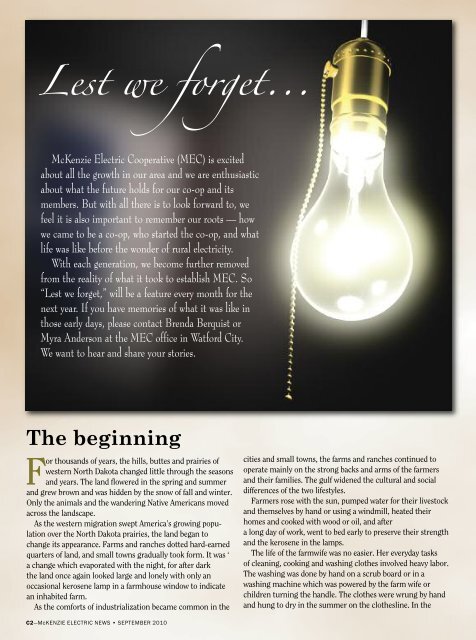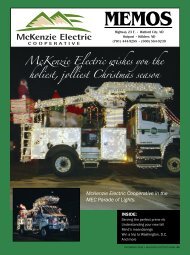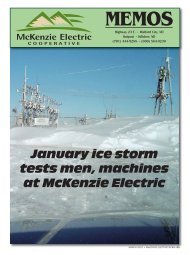Watford City, ND - McKenzie Electric Cooperative, Inc.
Watford City, ND - McKenzie Electric Cooperative, Inc.
Watford City, ND - McKenzie Electric Cooperative, Inc.
Create successful ePaper yourself
Turn your PDF publications into a flip-book with our unique Google optimized e-Paper software.
Lest we forget...<br />
<strong>McKenzie</strong> <strong>Electric</strong> <strong>Cooperative</strong> (MEC) is excited<br />
about all the growth in our area and we are enthusiastic<br />
about what the future holds for our co-op and its<br />
members. But with all there is to look forward to, we<br />
feel it is also important to remember our roots — how<br />
we came to be a co-op, who started the co-op, and what<br />
life was like before the wonder of rural electricity.<br />
With each generation, we become further removed<br />
from the reality of what it took to establish MEC. So<br />
“Lest we forget,” will be a feature every month for the<br />
next year. If you have memories of what it was like in<br />
those early days, please contact Brenda Berquist or<br />
Myra Anderson at the MEC office in <strong>Watford</strong> <strong>City</strong>.<br />
We want to hear and share your stories.<br />
The beginning<br />
For thousands of years, the hills, buttes and prairies of<br />
western North Dakota changed little through the seasons<br />
and years. The land flowered in the spring and summer<br />
and grew brown and was hidden by the snow of fall and winter.<br />
Only the animals and the wandering Native Americans moved<br />
across the landscape.<br />
As the western migration swept America’s growing population<br />
over the North Dakota prairies, the land began to<br />
change its appearance. Farms and ranches dotted hard-earned<br />
quarters of land, and small towns gradually took form. It was ‘<br />
a change which evaporated with the night, for after dark<br />
the land once again looked large and lonely with only an<br />
occasional kerosene lamp in a farmhouse window to indicate<br />
an inhabited farm.<br />
As the comforts of industrialization became common in the<br />
C2—McKENZIE ELECTRIC NEWS • SEPTEMBER 2010<br />
cities and small towns, the farms and ranches continued to<br />
operate mainly on the strong backs and arms of the farmers<br />
and their families. The gulf widened the cultural and social<br />
differences of the two lifestyles.<br />
Farmers rose with the sun, pumped water for their livestock<br />
and themselves by hand or using a windmill, heated their<br />
homes and cooked with wood or oil, and after<br />
a long day of work, went to bed early to preserve their strength<br />
and the kerosene in the lamps.<br />
The life of the farmwife was no easier. Her everyday tasks<br />
of cleaning, cooking and washing clothes involved heavy labor.<br />
The washing was done by hand on a scrub board or in a<br />
washing machine which was powered by the farm wife or<br />
children turning the handle. The clothes were wrung by hand<br />
and hung to dry in the summer on the clothesline. In the




